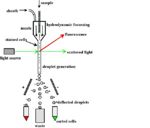Semen Sexing - Anatomy & Physiology
Jump to navigation
Jump to search
Principle
- X and Y chromosomes contain different quantities of DNA.
- X-bearing sperm contain 2.8-4.2% more DNA (species dependent) than Y-bearing sperm.
- This allows them to be sorted into two subpopulations.
- Separation requires the uptake of DNA stain/dye called Fluorochrome into living and dead sperm.
- X-bearing sperm take up more dye than Y-bearing sperm.
- Vital dyes emit light at a specific wavelength when excited or activated.
- X-bearing sperm will emit a larger signal than Y-bearing sperm.
- This allows the sperm to be sorted by flow cytometry.
Flow Cytometry
- Ejaculated spermatozoa are treated with a DNA dye (fluorochrome).
- X-bearing sperm absorb more dye than Y-bearing sperm.
- X-bearing sperm thus emit more intense light when excited by a laser.
- Sperm are also treated with a dye that greatly suppresses the signal from dead sperm.
- Dead sperm are therefore identified and rejected.
- Once spermatozoa enter the flow cytometer chamber, they pass single-file through a small nozzle.
- At a region just outside the nozzle, an excitation laser beam activates the fluorescent dye in each sperm.
- Each live sperm produces an emission with an intensity that is directly related to the quantity of DNA within the sperm head.
- X-bearing live sperm produce more intensity.
- A light sensing device is coupled to a computer that determines the intensity of light emission by each sperm and the order of passage of each sperm through a column below the nozzle.
- When the sperm pass through charged plates, they are assigned either a positive or negative charge depending on their DNA content (X or Y chromosome).
- When the microdroplet containing a single sperm passes through an electromagnetic field the computer applies an appropriate charge and directs the droplet (and sperm) to one side or the other.
- Dead sperm are discarded into the centre tube.
- At the end there are three vessels that contain sperm:
- One contains a high proportion of X-bearing sperm.
- One contains a high proportion of Y-bearing sperm.
- One contains dead sperm
